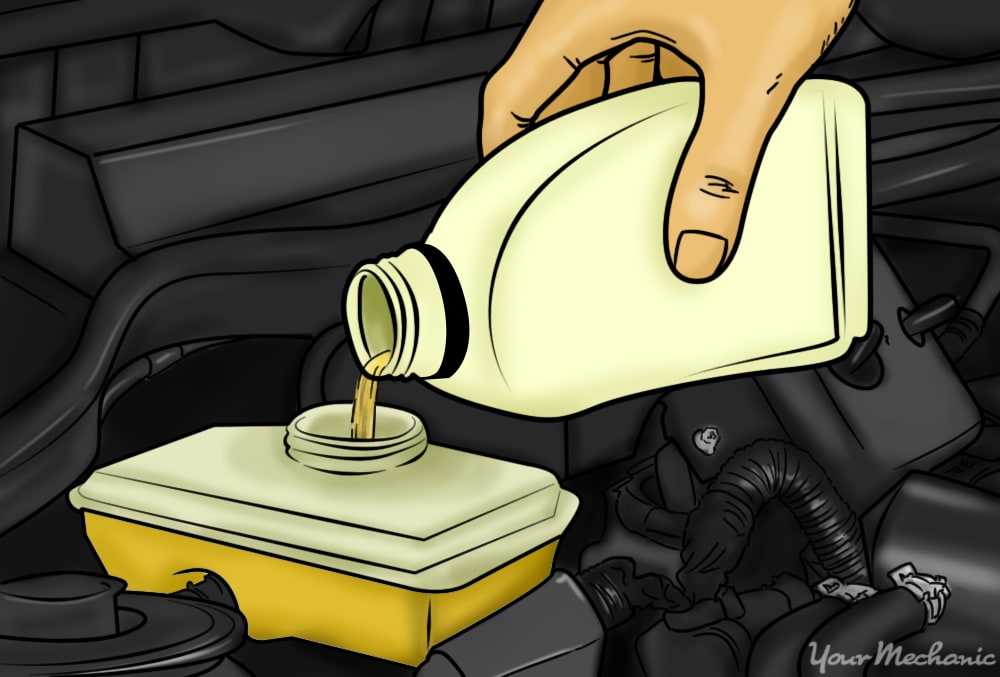

Without brake fluid, safely stopping your vehicle would be nearly impossible. Brake fluid travels through a series of brake hoses and lines as a hydraulic liquid — a fluid moving through a confined space while under pressure. It transfers the force of pushing on the brake pedal to brake calipers or drums to stop the vehicle’s motion.
Brake fluid is crucial to the braking system and must perform its duty under exacting conditions. According to the Department of Transportation’s National Highway Safety Administration (NHTSA), brake fluid must pass testing for 4 crucial standards:
- Remain fluid at low temperatures; it must not solidify by freezing.
- Resist boiling (and evaporating) at high temperatures.
- Operate with other parts of the brake system and other brake fluids.
- Mitigate the brake system corrosion.
After testing, all brake fluids are denoted with DOT (for the Department of Transportation) and a number representative of a higher boiling point. Most cars in America use the hygroscopic DOT 3 or 4, which means they will absorb moisture out of the air. Brake master cylinder reservoirs tend to be empty in case this begins to happen. They should not be opened unless absolutely necessary to prevent premature degradation caused by the absorption of heat and moisture. While this occurs naturally through braking, accelerating the process enhances the formation of rust and debris in the brake system — created by the increasingly acidic brake fluid.
There are several different types of brake fluid: DOT 3, DOT 4, and DOT 5, as well as a few subcategories. Typically, the lower the number, the lower the boiling point.
DOT 3
DOT 3 brake fluids are glycol-based and amber-colored. They have the lowest dry boiling point, meaning their boiling point when new, accompanied by a rather low wet boiling point, or temperature at which the fluid boils when degraded.
- Boiling Point: 401 degrees Fahrenheit
- Degraded Boiling Point: 284 degrees Fahrenheit
Since DOT 3 is hygroscopic, it needs replacing every few years to maintain effectiveness.
DOT 4
European car makers use mostly DOT 4 brake fluid. Though also glycol-based, it has a higher boiling point from borate-ester additives that reduce the acids formed by absorbed moisture. DOT 4 usually costs twice as much as DOT 3 to cover the extra chemicals. They perform better than DOT 3 fluids in their early life, but their boiling point ends up dropping rapidly in later stages.
- Boiling Point: Starting at 446 degrees Fahrenheit.
- Degraded Boiling Point: 311 degrees Fahrenheit
DOT 4 is growing in domestic use, however, it remains most common in European cars. It comes in a few different classifications, such as DOT 4 low viscosity (stickiness) and DOT 4 racing — often blue instead of amber-colored. While it can be mixed with DOT 3, there tends to be little benefit or difference to switching.
DOT 5
DOT 5 brake fluid is silicone-based, typically has a distinct purple hue, and costs about as much as DOT 4. It has a high boiling point and does not absorb water like the other types of brake fluid. DOT 5 does not work well in some brake systems because it becomes foamy and produces air bubbles that lead a spongy brake feeling. Additionally, since it does not absorb moisture, any liquid that enters the system corrodes it quickly and contribute to freezing or boiling at unfavorable temperatures.
- Dry Boiling Point: 500 degrees Fahrenheit.
- Wet Boiling Point: 356 degrees Fahrenheit.
Due to their different properties, DOT 5 should never be mixed with other brake fluids. It is designed for vehicles that sit in storage for extended periods of time, such as military vehicles, and can perform immediately when needed. Despite their higher boiling point and anti-corrosion properties, car manufacturers avoid the silicone-based brake fluid because of its low air and lack of water solubility.
DOT 5.1
DOT 5.1 has a similar boiling point to DOT 4 racing fluids, a glycol-base, and a color scheme that ranges from light amber to translucent. DOT 5.1 is basically a DOT 4 brake fluid, based on chemical makeup, that can meet DOT 5 regulations.
- Dry Boiling Point: 500 degrees Fahrenheit.
- Wet Boiling Point: 356 degrees Fahrenheit.
It can be up to 14 times more expensive then DOT 3, but can technically mix with both DOT 3 and DOT 4 fluids.
DOT 2
Not widely used in the automotive industry, DOT 2 brake fluid is mineral oil-based and has markedly low wet and dry boiling points. In fact, its dry boiling point is the wet boiling point of DOT 5 and DOT 5.1 brake fluids.
- Dry Boiling Point: 374 degrees Fahrenheit.
- Wet Boiling Point: 284 degrees Fahrenheit.
What Type of Brake Fluid Should You Use?
Old brake fluid can clog systems from the buildup of rust or deposits and requires changing at designated intervals. Always refer to your car manufacturer’s guidelines when it comes to selecting a brake fluid. Brake fluid should also be flushed or changed according to manufacturer recommendations.
Brake fluids should always be handled with care. They are highly corrosive and damaging to paint and other coatings if spilled. Plus, they can be harmful if swallowed and should avoid contact with skin or eyes. When having your brake system flushed, make sure the new brake fluid used is stored properly and old fluid is disposed of safely. The average car owner will need DOT 3, DOT 4, or DOT 5.1 for their car, but always defer to factory specifications to keep your brake system running properly.



